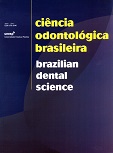Biocompatibility of anionic collagen matrices and its influence on the orientation of cellular growth.
DOI:
https://doi.org/10.14295/bds.2007.v10i3.272Resumo
This study aimed to analyze the biocompatibility of anionic collagen matrices, the local bone response following implantation in surgically-created bone defects, and also the influence of the collagen fiber orientation on the neoformed osseous tissue. Seventy two rats (Rattus norvegicus albinus) were used in this experiment. The animals were divided into four experimental groups: Group 1 (control), without implants; Group 2, pericardium medullar implants 12 hours; Group 3, medullar implants of tendon 24 hours, with the long axis of collagen fibers oriented parallel to the long axis of the tibia; and Group 4, medullar implants of tendon 24 hours, with the long axis of collagen fibers perpendicular to the long axis of the tibia. After the experimental surgery, the evolution of the repair process was microscopically evaluated at 7, 15, and 30 days post-surgery. The results demonstrated that the mplanted matrices are biocompatible and act as a scaffold inducing bone formation, mainly in the Group 4 animals. At first, cellularity follows the arrangement of collagen fibers, later obtaining a multidirectional growth.Downloads
Downloads
Publicado
Como Citar
Edição
Seção
Licença
TRANSFERÊNCIA DE DIREITOS AUTORAIS E DECLARAÇÃO DE RESPONSABILIDADE
Toda a propriedade de direitos autorais do artigo "____________________________________________________________________" é transferido do autor(es) para a CIÊNCIA ODONTOLÓGICA BRASILEIRA, no caso do trabalho ser publicado. O artigo não foi publicado em outro lugar e não foi submetido simultaneamente para publicação em outra revista.
Vimos por meio deste, atestar que trabalho é original e não apresenta dados manipulados, fraude ou plágio. Fizemos contribuição científica significativa para o estudo e estamos cientes dos dados apresentados e de acordo com a versão final do artigo. Assumimos total responsabilidade pelos aspectos éticos do estudo.
Este texto deve ser impresso e assinado por todos os autores. A versão digitalizada deverá ser apresentada como arquivo suplementar durante o processo de submissão.




























